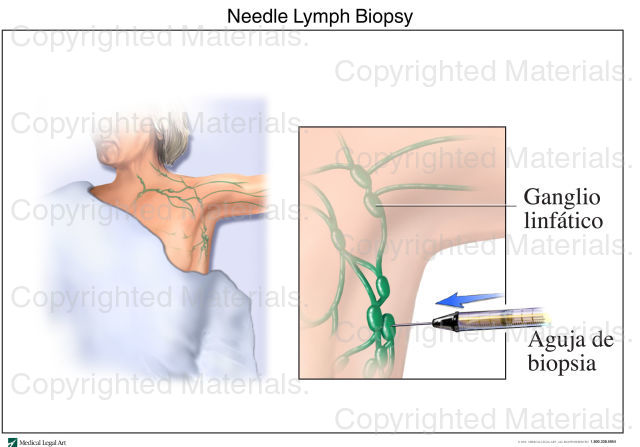A lymph node biopsy is needed to make a diagnosis for most types of lymphoma.
What is a lymph node biopsy?
A biopsy is one of the most important steps in diagnosing lymphoma. It involves the removal of a sample of tissue (cells), usually performed by a surgeon. The cells are then examined under a microscope.
A lymph node biopsy is used to confirm the diagnosis of lymphoma. If you already have a diagnosis of lymphoma, the doctors can look at the cells to find out more about the type of lymphoma.

Types of lymph node biopsies
There are different types of biopsy, including:
Excisional biopsy
An excisional biopsy removes a whole lymph node. This is the most common type of biopsy. It involves a minor operation. If the lymph node is near the surface of the skin you will most likely require a local anaesthetic (the area will be numb so you cannot feel anything but you will not be completely asleep). If the lymph node is deeper inside your body, then you may need to have a general anaesthetic (Where you will be asleep during the procedure).
An excisional node biopsy is the best investigative option, as it collects the most adequate amount of tissue to be able to do the necessary testing for a diagnosis.
You may need to have a scan before the biopsy. This will guide the surgeon to the exact place to take the biopsy. Once the lymph node is removed, it is sent to a laboratory for examination. The area will be stitched and covered.
You will be given information on how to care for the wound. If you do not receive this information, make sure you ask for it. In most cases you will be able to go home the same day you have the procedure. It is advisable to have someone collect you and take you home. If you receive a general anaesthetic, you will not be able to drive.
Incisional biopsy
An incisional biopsy, which removes part of a lymph node. An incisional biopsy is often used when lymph nodes are large from being swollen or matted. The procedure is similar to that of an excision biopsy although only part (instead of all) of a lymph node is removed.
Core needle biopsy
A core needle biopsy, which takes a small sample of a lymph node; this type of biopsy is also known as a ‘core biopsy’ or a ‘needle biopsy’.
This is generally done using a local anaesthetic to make the area numb. The area will be cleaned and then the doctor will insert a hollow needle and remove a small piece of tissue from the lymph node. If the node is close to the skin the doctor will feel the area to be biopsied.
If the node is deeper than an ultrasound or CT scan will be used to help the doctor locate the best place to take the sample. A dressing will be placed on the site. You can usually go home after the procedure.
Fine needle aspirate (FNA)
A fine needle aspirate (FNA) is occasionally done if doctors suspect that you could have lymphoma. This is often the first biopsy that your doctor may have ordered to have done.
A fine needle aspirate uses a very thin, hollow needle attached to a syringe to take out a small amount of fluid and very small pieces of tissue from the tumour. The doctor will insert a needle for around 30 seconds. For lymph nodes closer to the surface of the skin this will be done with the doctor feeling the lymph node.
If the node is deeper than an ultrasound a CT scan will be used to assist the doctor to locate the best place to take the sample. Although a fine needle aspirate can help doctors find out if you have lymphoma, it is not enough on its own.
Further tests such as an excisional or incisional biopsy will be needed to confirm the diagnosis of lymphoma.
What happens after the biopsy?
The biopsied area will be covered by a protective dressing and the medical team will give you clear instructions on how to care for the area. In most cases the dressing will stay on for 2-3 days. You should avoid getting the area very wet, for example in a pool or bath and this is to try and prevent any infections. The area should be monitored for any bleeding, swelling or signs of infection such as discharge or a fever (temperature above 38 degrees Celsius). It is important that you contact your doctor immediately if you notice any signs of infection.
Getting your results
It can take some time to get the test results back. Often samples have multiple tests done on them and sometimes samples need to be sent away for laboratories to test them. Whilst this is being done, your doctors may send you off to have other tests such as scans or blood tests.
Waiting for results can be a difficult time, you understandably may be very worried during this time. You should speak with your doctor to find out how long it will take for the results to come back. It may also help to discuss this with your family and GP.

